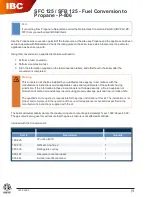
C 17
•
A common condensate pump/sump may be used.
Run separate piping from each condensate drain to
the sump. A common drain may be used to dis-
charge condensate from the sump. Consult pump/
sump manufacturer for compatibility of pump/sump
materials of construction. If a common sump is used,
individual drain lines should be connected such that
one drain cannot back feed into another drain.
•
Consult local authorities regarding disposal of ue
gas condensate into public waste water system.
Some jurisdictions require that the condensate be
buffered before discharge. This buffering is commonly
achieved by draining the condensate through a lime-
stone (calcium carbonate) bed. The condensate will
be slightly acidic and range between 3-5 on the pH
scale. Consult Ajax Boiler Inc., or a chemical treat-
ment company regarding buffering systems.
C.11. M
ODULAR
S
YSTEM
I
NSTALLATIONS
Multiple Triton Series boilers may be installed together, or
as part of a single, modular lead-lag system. Up to 8 indi-
vidual boilers may be installed using standard controls.
C.11.a. General
•
Read and follow all venting, combustion air, water pip-
ing, gas piping and electrical instructions contained in
this manual unless otherwise instructed in this section.
•
Design and installation of modular systems should only
be undertaken by skilled and knowledgeable engineers
and contractors.
•
Consult Local Building Codes, National Fuel Gas Code,
or NFPA 54/ANSI Z223.1 for restrictions and instruc-
tions for modular boilers.
•
Refer to section
2. Pre-Installation
for further warn-
ings, cautions, notices and instructions.
C.11.b. Sizing
Consult your system mechanical engineer, or Ajax Boiler
Inc. for recommended number and size of boilers for a
given input.
C.11.c. Venting
This section outlines venting requirements for multiple
boiler installations and should be used in addition to the “
B.3. C
OMBUSTION AND
V
ENTILATION
A
IR
”
and
“B.4. C
ON
-
VEN
TIONAL
F
LUE
V
ENTING
”
sections earlier in this manual.
Positive Pressure (Sidewall and Vertical) Venting
!
CAUTION:
DO NOT manifold vent components of multiple boilers
without converting to a negative pressure venting ar-
rangement.
•
Positive pressure vent systems cannot be manifolded
together.
•
Positive pressure systems can be piped individually
through a common vertical or horizontal chase provid-
ed minimum clearances to combustible materials are
maintained.
•
Positive pressure systems can be piped individually
through a common vertical chase so that a single roof
penetration can be made. Each vent termination must
be one (1) foot from all other terminations.
Negative Pressure (Conventional) Venting
!
WARNING:
Installing multiple vent terminations close together pro-
motes frost build up on buildings. To minimize this pos-
sibility, extend the distance from the building to the end of
the vent termination and increase the horizontal distance
between vent terminations.
•
Refer to National Fuel Gas Code to determine required
chimney diameter and common venting diameter. Note
that combined input, lateral length and chimney height
affect vent diameter.
•
Install a double acting barometric damper with integral
ue spillage interlock.
•
Locate boiler(s) with lowest input closest to chimney/
vertical common vent.
•
Chimney lining must be acceptable for use with con-
densing ue gases.
•
Install a condensate drain to collect any condensate
that may form in the lined chimney or vertical common
vent.
Air Intake Piping
•
Consult the system mechanical engineer or intake pipe
manufacturer for common air intake pipe sizing.
•
Refer to Figures 11 and 12 for common air intake
guidelines for modular boilers.
•
Individual air intake pipes may be used in lieu of com-
mon air intake piping.
•
Common air intake straight lengths and ttings should
be assumed to have the equivalent length the same
as an individual air intake pipe, used for a given boiler
intake pipe diameter.
Consult local authorities regarding disposal of flue
gas condensate into public waste water system.
Some jurisdictions require that the condensate be
buffered before discharge. This buffering is commonly
achieved by draining the condensate through a limestone
(calcium carbonate) bed. The condensate will
be slightly acidic and range between 3-5 on the pH
scale. Consult Ace Heating Solutions, LLC, or a chemical
treatment company regarding buffering systems.
Consult your system mechanical engineer, or Ace Heating
Solutions, LLC for recommended number and size of
boilers for a given input.
Содержание Triton T-80
Страница 31: ...E 29 E 3 ELECTICAL WIRING DIAGRAM ...
Страница 43: ...F 41 ...
Страница 44: ...F 42 ...
Страница 45: ...F 43 ...
Страница 46: ...F 44 Notes ...
















































